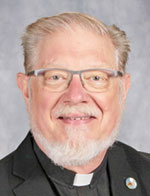That All May Be One / Fr. Rick Ginther
Nov. 16 talk to highlight interreligious dialogue, Vatican II document
 “Nostra Aetate” is 60 years old! So what?
“Nostra Aetate” is 60 years old! So what?
“In our time … .” Those are the opening words of this “Declaration on the Relation of the Church to Non-Christian Religions” of the Second Vatican Council. It was promulgated on Oct. 28, 1965, by Pope Paul VI.
The bishops of the Second Vatican Council had approved it by a vote of 2,221 to 88.
The document speaks of the universal human longing for encounter with and meaning from the divine. It formally mentions Islam, Buddhism and Judaism.
From this document sprang a series of dialogues between the Roman Catholic Church and many of the religions of the world.
These dialogues are formal in structure and inclusive of scholars and theologians. There is a bishop appointed to co-lead with a like appointed co-leader of the other religion.
Currently, active dialogues exist with Judaism, Islam, Buddhism, Hinduism and Sikhism. There are also multilateral dialogues.
Among those dialogues, the dialogue with rabbinic Judaism is most important.
The 2,000 years of Jewish/Catholic Christian relations is checkered. Sadly, the effects of negative encounters, condemnations, intolerance and persecution were seared in many minds and hearts. The estrangement was intense.
And then, “Nostra Aetate” opened the door to a more loving and peaceful relationship.
The Roman Catholic Church, being the largest Christian body in the world, took a giant stride with “Nostra Aetate.” For the first time, an official Church document addressed the relationship that Catholics are to have with Jews.
This came about, in part, through the thoughts of Pope Saint John XXIII. Before his death, he wrote a statement which he intended to be read aloud in all Catholic churches of the world on a fixed date:
“We are conscious today that many, many centuries of blindness have cloaked our eyes so that we can no longer either see the beauty of [God’s] Chosen People nor recognize in their faces the features of our privileged brethren. We realize that the mark of Cain stands upon our foreheads. Across the centuries, our brother Abel has lain in the blood which we drew or shed the tears we caused by forgetting Thy Love. Forgive us for the curse we falsely attached to their name as Jews. Forgive us for crucifying Thee a second time in their flesh. For we knew not what we did.”
At 1,793 words, “Nostra Aetate” is the shortest of all the council’s documents. Among those words of urgings and insights are:
“The Church keeps ever in mind the words of the Apostle about his kinsmen: ‘theirs is the sonship and the glory and the covenants and the law and the worship and the promises; theirs are the fathers and from them is the Christ according to the flesh’[Rom. 9:4-5], the Son of the Virgin Mary. She also recalls that the Apostles, the Church’s mainstay and pillars, as well as most of the early disciples who proclaimed Christ’s Gospel to the world, sprang from the Jewish people” (#4).
The full document is so worth reading!
A fuller exploration of its meaning and import will take place at SS. Peter and Paul Cathedral in Indianapolis at 7 p.m. on Nov. 16. Dr. Philip A. Cunningham, director of the Institute for Jewish-Catholic Relations at St. Joseph’s University in Philadelphia, will offer reflections on the document’s enduring legacy. A panel discussion will follow with Archbishop Charles C. Thompson and Rabbi Dennis Sasso, senior rabbi emeritus of Congregation Beth-Elzedek in Indianapolis.
This event is sponsored by the archdiocese and the Jewish Community Relations Council. Admission is free but registration is requested. To register, go to tinyurl.com/NostraAetateEvent.
(Father Rick Ginther is director of the archdiocesan Office of Ecumenism and Interreligious Affairs. He is retired from full-time pastoral ministry, but is still active as a priest of the archdiocese.) †
 “Nostra Aetate” is 60 years old! So what?
“Nostra Aetate” is 60 years old! So what?